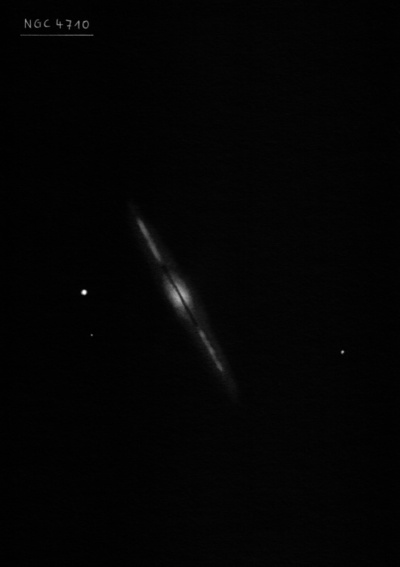
William Herschel discovered NGC 4710 = H II-95 = h1441 on 21 Mar 1784 (sweep 182) and noted "pB, vmE. The direction of extent is nearly in the meridian or perhaps about 5 or more degree sp and nf." His position was poor, but JH observed the galaxy twice, noting "vB; vmE; pos = 28.5° by micrometer; bM; 90" long" and measured an accurate position.
A total of 12 observations were made at Birr Castle. On 16 Feb 1855, R.J. Mitchell wrote "vB ray, a dark band across on each side of nucleus, separating it from the extremities." The dark lane was commented on in each observation. On 16 Apr 1855, he wrote "My sketch exaggerates the dark lines, they should be broader and not so well defined. Mr. Johnstone Stoney [visiting between professorial duties] remarked a second dark line across the n branch near its extremity." On 13 Apr 1876, Dreyer logged "cB, pL, bM, no very defined Nucl, E 28.2°, about 230" long. On both side of Nucl are dark bands. The n end of neb is brighter than s one and the maximum of brightness is about 40" from the end. Maximum in s part is nearer the nucleus. Centre looks a little oval with higher power."
400/500mm - 17.5" (5/14/94): beautiful edge-on 5:1 SSW-NNE (PA 30°), bright bulging core. Distinctly mottled with an irregular surface brightness and clearly brighter along the NNE extension. A mag 13 star is 1.4' E of center. At 280x, the dimensions are 3.5'x0.6' and the galaxy appears to have a sharper light cut-off along the preceding edge possibly due to dust. Very mottled with a couple of bright and dark patches along the major axis. IC 3806 lies 19' SW.
Notes by Steve Gottlieb